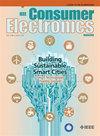Guest Editorial of the Special Section on Tactile Internet for Consumer Internet of Things Opportunities and Challenges
IF 4.3
2区 计算机科学
Q1 ENGINEERING, ELECTRICAL & ELECTRONIC
引用次数: 0
Abstract
The Tactile Internet (TI) is a logical transition of the Internet, which has progressed from a static, text-based Internet to a multimedia mobile Internet and finally to a Consumer Internet of Things (IoT). The major requirement of any TI applications is low latency, fast transit intervals, high availability, and a high level of security. For instance, latency requirement in Human to Machine (H2M) interactions may vary from < 10 ms up to tens of milliseconds and round-trip latency of 1 ms. This necessitates tactile applications close to end users to minimize delays. Edge Computing (EC) is a resource-rich decentralized platform that offers cloud computing functionalities at cellular base stations near users, saving energy and time on backhaul transmission to cloud servers. In a typical network security architecture of TI, the network administrator establishes network security policies, which segregate network traffic. However, deploying EC at the Internet edge places a strain on network management policies, making them subject to attacks such as Denial-of-Service (DoS), which can harm EC and produce unnecessary network traffic. This type of attack is restricted to EC nodes and has little effect on the backhaul network (such as cloud computing), which is more secure. Therefore, with the growing number of attack vectors, it is essential to develop security solutions for EC to enable computing-based TI applications secure and give application developers more alternatives. The Convergence of Cloud, EC, AI, and blockchain can potentially tackle major shortcomings of TI-driven Consumer IoT, its adoption is still in its infancy, suffering from various issues, such as lack of consensus towards any reference models or best practices.面向消费物联网的触觉互联网机遇与挑战》特刊客座编辑
触觉互联网(TI)是互联网的逻辑过渡,它从静态、基于文本的互联网发展到多媒体移动互联网,最后发展到消费物联网(IoT)。任何 TI 应用的主要要求都是低延迟、快速传输间隔、高可用性和高安全性。例如,人机(H2M)交互的延迟要求可能从 10 毫秒到几十毫秒不等,往返延迟可达 1 毫秒。这就要求触觉应用靠近终端用户,以尽量减少延迟。边缘计算(EC)是一种资源丰富的分散式平台,可在用户附近的蜂窝基站提供云计算功能,从而节省向云服务器回程传输的能源和时间。在典型的 TI 网络安全架构中,网络管理员建立网络安全策略,隔离网络流量。然而,在互联网边缘部署 EC 会给网络管理策略带来压力,使其受到拒绝服务(DoS)等攻击,从而损害 EC 并产生不必要的网络流量。这类攻击仅限于 EC 节点,对更安全的回程网络(如云计算)影响不大。因此,随着攻击载体的日益增多,必须为 EC 开发安全解决方案,以确保基于计算的 TI 应用安全,并为应用开发人员提供更多选择。云、EC、人工智能和区块链的融合有可能解决 TI 驱动的消费类物联网的主要缺点,但其应用仍处于起步阶段,存在各种问题,例如缺乏对任何参考模型或最佳实践的共识。
本文章由计算机程序翻译,如有差异,请以英文原文为准。
求助全文
约1分钟内获得全文
求助全文
来源期刊
CiteScore
7.70
自引率
9.30%
发文量
59
审稿时长
3.3 months
期刊介绍:
The main focus for the IEEE Transactions on Consumer Electronics is the engineering and research aspects of the theory, design, construction, manufacture or end use of mass market electronics, systems, software and services for consumers.

 求助内容:
求助内容: 应助结果提醒方式:
应助结果提醒方式:


